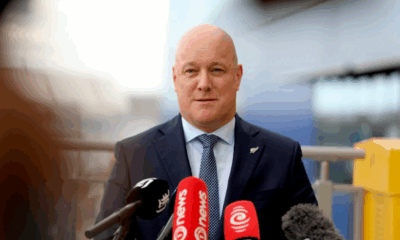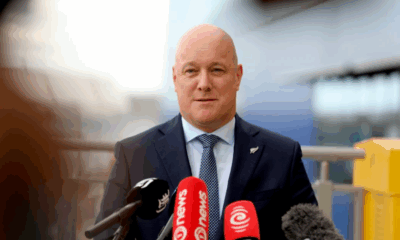Business
Expert Tips for Parents to Teach Kids Financial Savvy

Parents aspire to provide their children with a financially secure future, but guiding them on this path can be challenging. Financial experts emphasize the importance of instilling good money habits early on. By leveraging tools such as savings accounts and investment funds, parents can effectively prepare their children for financial independence.
The Role of KiwiSaver in Financial Education
Despite the absence of a direct incentive to sign up, experts like Fiona Mackenzie, head of investments at ANZ, advocate for the benefits of KiwiSaver for young people. “Opening a KiwiSaver account and regularly contributing can help kids develop a lifelong savings habit,” Mackenzie explained. KiwiSaver not only aids in saving for a first home but also provides a foundation for life after retirement.
From the age of 16, children become eligible for government contributions to their KiwiSaver accounts. Starting in April 2026, they will also qualify for employer contributions, provided they meet certain criteria. While KiwiSaver is a valuable long-term savings tool, Mackenzie advises parents to consider additional options, such as traditional savings accounts or investment funds, particularly for shorter-term goals like education or travel.
Investment funds can offer a diversified approach to saving. “Some parents opt for a layered strategy, using KiwiSaver for long-term gains and other accounts for flexible investing,” she added. By establishing their own bank accounts, children can gain firsthand experience with managing money, fostering a sense of ownership.
Maximizing Contributions and Involvement
According to Mike Taylor, founder of Pie Funds, they are the only KiwiSaver provider waiving fees for children under the age of 13. “This incentive encourages parents to start a regular savings plan for their children as early as possible,” Taylor noted. With a modest weekly contribution of $20, children could accumulate approximately $50,000 by their 18th birthday, assuming a 10 percent return on investments.
Taylor shared his personal experience, stating, “I have done this for all of my kids, contributing slightly more. My first child turns 18 next year and will have funds available for university or a house deposit.” This proactive approach alleviates the common dilemma of financial assistance from parents later in life.
Family contributions can also play a vital role in a child’s financial education. Stephanie Pow, founder of Crayon, suggests that gifts from family members can be directed towards a child’s investment fund. “Instead of more toys, family members might contribute to the children’s financial future during occasions like birthdays or Chinese New Year,” she explained. Such contributions leverage the power of time and compounding, enhancing the child’s financial prospects.
Parents often face a decision regarding whether to invest in their child’s name or on their behalf. Pow advises caution, stating, “If you invest in the child’s name, they will need an IRD number, and it becomes their money.” While this arrangement could potentially lead to responsible financial behavior, there are risks involved, such as the child withdrawing funds for unintended purposes. Conversely, money held in a parent’s name may be subject to different financial implications in cases of bankruptcy or relationship breakdowns.
Communication about money is crucial. Mackenzie urges parents to talk openly with their children, especially in a world where physical currency is less visible. “Demonstrating how compound interest works can ignite their curiosity,” she said. Engaging children in discussions about savings goals, whether for toys or larger purchases, can help them understand the value of setting targets and developing a savings plan.
Teaching children to save effectively involves instilling habits such as “paying themselves first.” Mackenzie recommends that children set aside a portion, around 10 percent, of any money they receive before spending the rest. Real-life lessons, like adding bonuses to their savings, can illustrate the benefits of saving.
Before initiating investments for their children, parents should ensure their own financial stability. Pow emphasizes the importance of addressing personal financial health, stating, “You wouldn’t increase your KiwiSaver contributions if you don’t have an emergency fund.” This foundational stability is crucial before setting aside money for children’s future investments.
In conclusion, fostering financial literacy in children requires a multifaceted approach. By utilizing tools like KiwiSaver, engaging family contributions, and maintaining open lines of communication, parents can empower their children to navigate their financial futures with confidence.
-

 World3 weeks ago
World3 weeks agoPrivate Funeral Held for Dean Field and His Three Children
-

 Top Stories3 weeks ago
Top Stories3 weeks agoFuneral Planned for Field Siblings After Tragic House Fire
-

 Sports3 months ago
Sports3 months agoNetball New Zealand Stands Down Dame Noeline Taurua for Series
-

 Entertainment3 months ago
Entertainment3 months agoTributes Pour In for Lachlan Rofe, Reality Star, Dead at 47
-

 Entertainment2 months ago
Entertainment2 months agoNew ‘Maverick’ Chaser Joins Beat the Chasers Season Finale
-

 Sports3 months ago
Sports3 months agoSilver Ferns Legend Laura Langman Criticizes Team’s Attitude
-

 Sports1 month ago
Sports1 month agoEli Katoa Rushed to Hospital After Sideline Incident During Match
-

 Politics2 months ago
Politics2 months agoNetball NZ Calls for Respect Amid Dame Taurua’s Standoff
-

 World4 weeks ago
World4 weeks agoInvestigation Underway in Tragic Sanson House Fire Involving Family
-

 Entertainment7 days ago
Entertainment7 days agoJacinda Ardern Discusses Popularity Decline on Graham Norton Show
-

 Top Stories3 weeks ago
Top Stories3 weeks agoShock and Grief Follow Tragic Family Deaths in New Zealand
-

 Sports2 weeks ago
Sports2 weeks agoEli Katoa Shares Positive Recovery Update After Brain Surgery





















